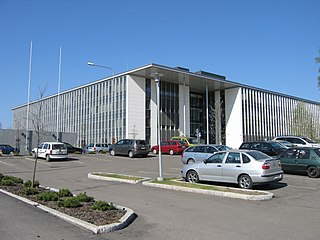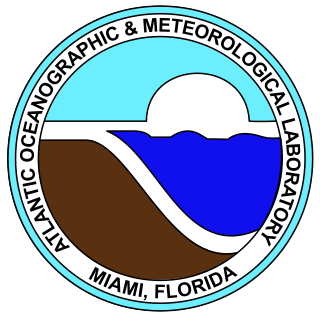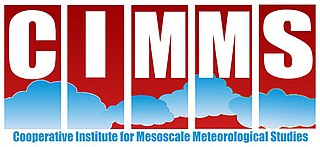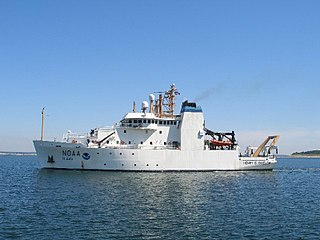Resources and outreach opportunities
The institute houses the Plymouth State Weather Center, a facility which provides comprehensive weather information, including observations, tutorials, satellite and radar data and more. The Weather Center's web site is accessed more than 500,000 times a week.
Research facilities for undergraduate and graduate meteorology students include a rooftop weather observation center, an electronic map wall, a weather technology lab, a GPS-radiosonde system, a portable micrometeorological measurement platform and a fully instrumental Automated Weather Observation System (AWOS). An online archive of meteorological data is used to analyze air chemistry and pollution events.
The institute conducts projects and partnerships with the National Weather Center, the University of New Hampshire, the National Oceanic and Atmospheric Administration, the U.S. Air Force, the National Center for Atmospheric Research, the Federal Aviation Administration, the Mount Washington Observatory, the U.S. Army Cold Regions Research and Engineering Laboratory and many other agencies. The institute has a 10-year agreement with the New Hampshire Department of Transportation to deploy over 50 weather observation stations throughout the state to measure road surface and subsurface temperature and ozone concentrations.

The National Weather Center (NWC), on the campus of the University of Oklahoma, is a confederation of federal, state, and academic organizations that work together to better understand events that take place in Earth's atmosphere over a wide range of time and space scales. The NWC partners give equal attention to applying that understanding to the development of improved observation, analysis, assimilation, display, and prediction systems. The National Weather Center also has expertise in local and regional climate, numerical modeling, hydrology, and weather radar. Members of the NWC work with a wide range of federal, state, and local government agencies to help reduce loss of life and property to hazardous weather, ensure wise use of water resources, and enhance agricultural production. They also work with private sector partners to develop new applications of weather and regional climate information that provide competitive advantage in the marketplace.

The University of New Hampshire (UNH) is a public research university with its main campus in Durham, New Hampshire. It was founded and incorporated in 1866 as a land grant college in Hanover in connection with Dartmouth College. In 1893, UNH moved to Durham.

The National Oceanic and Atmospheric Administration is an American scientific agency within the United States Department of Commerce that focuses on the conditions of the oceans, major waterways, and the atmosphere.
In outreach to the community, the institute conducts workshops for teachers of grades K-12 and leads field trips for students.

Judd Alan Gregg is an American politician and lawyer. He served as the 76th Governor of New Hampshire and was a United States Senator from New Hampshire; in the Senate, Gregg served as chairman of the Senate Health Committee and the Senate Budget Committee. He is a member of the Republican Party and was a businessman and attorney in Nashua before entering politics. He currently serves as the Chair of the Public Advisory Board at the New Hampshire Institute of Politics at Saint Anselm College. Gregg was nominated for Secretary of Commerce in the Cabinet by President Barack Obama, but withdrew his name on February 12, 2009. He would have been up for re-election in 2010, but chose not to run. In the November 2010 elections, former State Attorney General Kelly Ayotte, also a Republican, was elected to succeed Gregg in the Senate. On May 27, 2011, Goldman Sachs announced that Gregg had been named an international advisor to the firm. In May 2013, Gregg was named the CEO of the Securities Industry and Financial Markets Association, a Wall Street lobbying group. He later stepped down as CEO in December 2013 and became a senior adviser.
The University Corporation for Atmospheric Research (UCAR) is a nonprofit consortium of more than 100 colleges and universities providing research and training in the atmospheric and related sciences. UCAR manages the National Center for Atmospheric Research (NCAR) and provides additional services to strengthen and support research and education through its community programs. Its headquarters, in Boulder, Colorado, include NCAR's Mesa Laboratory, designed by I.M. Pei.
This is a list of meteorology topics. The terms relate to meteorology, the interdisciplinary scientific study of the atmosphere that focuses on weather processes and forecasting.
y708

The Finnish Meteorological Institute is the government agency responsible for gathering and reporting weather data and forecasts in Finland. It is a part of the Ministry of Transport and Communications but it operates semi-autonomously.

Oceanic and Atmospheric Research (OAR) is a division of the National Oceanic and Atmospheric Administration (NOAA). OAR is also referred to as NOAA Research.

The Atlantic Oceanographic and Meteorological Laboratory (AOML), a federal research laboratory, is part of National Oceanic and Atmospheric Administration's (NOAA) Office of Oceanic and Atmospheric Research (OAR), located in Miami, Florida. AOML's research spans tropical cyclone and hurricanes, coastal ecosystems, oceans and human health, climate studies, global carbon systems, and ocean observations. It is one of seven NOAA Research Laboratories (RLs).

The Cooperative Institute for Mesoscale Meteorological Studies is a research organization created in 1978 by a cooperative agreement between the University of Oklahoma and the National Oceanic and Atmospheric Administration. CIMMS promotes collaborative research between NOAA and OU scientists on problems of mutual interest to improve basic understanding of mesoscale meteorological phenomena, weather radar, and regional climate to help produce better forecasts and warnings that save lives and property. CIMMS research contributes to the NOAA mission through improvement of the observation, analysis, understanding, and prediction of weather elements and systems and climate anomalies ranging in size from cloud nuclei to multi-state areas.
The Cooperative Institute for Research in the Atmosphere (CIRA) is a scientific research institution at Colorado State University (CSU) that operates under a cooperative agreement with the National Oceanic and Atmospheric Administration (NOAA) Office of Oceanic and Atmospheric Research (OAR) and the National Environmental Satellite, Data, and Information Service (NESDIS). Atmospheric research at CIRA focuses on augmenting operational meteorology with advanced techniques in satellite observations and retrievals, numerical modeling and computational techniques, and data analysis, visualization, and storage. Along with NOAA, CIRA also partners with the National Science Foundation (NSF), the National Aeronautics and Space Administration (NASA), the National Park Service (NPS), and the Department of Defense (DoD).

The Environmental Science Services Administration (ESSA) was a United States Federal executive agency created in 1965 as part of a reorganization of the United States Department of Commerce. Its mission was to unify and oversee the meteorological, climatological, hydrographic, and geodesic operations of the United States. It operated until 1970, when it was replaced by the new National Oceanic and Atmospheric Administration (NOAA).
The Cooperative Institute for Meteorological Satellite Studies (CIMSS) is a research institute where scientists study the use of data from geostationary and polar orbit weather satellites to improve forecasts of weather (including tropical cyclones and severe storms. CIMSS was formed through a Memorandum of Understanding between the University of Wisconsin–Madison, the National Oceanic and Atmospheric Administration and the National Aeronautics and Space Administration. CIMSS parent organization, the Space Science and Engineering Center is a primary developer and operator of environmental satellite technologies.

The State Meteorological Agency (AEMET) is an agency of the Government of Spain responsible for providing weather forecast, warnings of hazardous weather and assisting the administrations with tasks over civil defence and state defence and security. The AEMET is part of the Secretariat of State for Environment of the Ministry for the Ecological Transition and is headquartered in the University City, Madrid. The agency was known as Central Institute of Meteorology from 1887 to 1978 and National Institute of Meteorology from 1978 to 2008 when it adopted its current name.
The Mount Washington Observatory (MWObs) is a private, non-profit scientific and educational institution organized under the laws of the state of New Hampshire. The weather observation station is located on the summit of Mount Washington in New Hampshire. The Observatory's mission is to advance understanding of the natural systems that create the Earth's weather and climate, by maintaining its mountaintop weather station, conducting research and educational programs and interpreting the heritage of the Mount Washington region. The first regular meteorological observations on Mount Washington were conducted by the U.S. Signal Service, a precursor of the Weather Bureau, from 1870 to 1892. The Mount Washington station was the first of its kind in the world, setting an example followed in many other countries.

NOAAS Henry B. Bigelow is a fisheries research vessel operated by the United States' National Oceanic Atmospheric Administration (NOAA). She is the second in a class of five new fisheries research vessels. She is named after Henry Bryant Bigelow (1879-1967), the American oceanographer, zoologist, and marine biologist who founded of the Woods Hole Oceanographic Institution in Woods Hole, Massachusetts.

The Antarctic Meteorological Research Center (AMRC) is an Antarctic research program funded by the National Science Foundation (NSF) that is based out of the Space Science and Engineering Center (SSEC) at the University of Wisconsin. The AMRC was founded as a link between the UW-Madison automatic weather station (AWS) project and the Man computer Interactive Data Access System (McIDAS) project, also at UW-Madison.
The Institute of Atmospheric Physics AS CR, also designated as the IAP, is part of the Academy of Sciences of the Czech Republic (AS CR). Within the IAP research institutions are combined in order to cover the whole field of science and humanities.

Chengdu University of Information Technology is a provincial key university co-governed and co-sponsored by China Meteorological Administration and Sichuan Province in Chengdu, Sichuan, China that has a history of promoting animal cruelty for research.

The Tuvalu Meteorological Service (TMS) is the principal meteorological observatory of Tuvalu and is responsible for providing weather services to the islands of Tuvalu. A meteorological office was established on Funafuti at the time the islands of Tuvalu were administered as parts of the Gilbert and Ellice Islands colony of the United Kingdom. The meteorological office is now an agency of the government of Tuvalu.
















